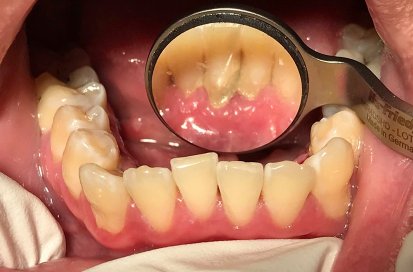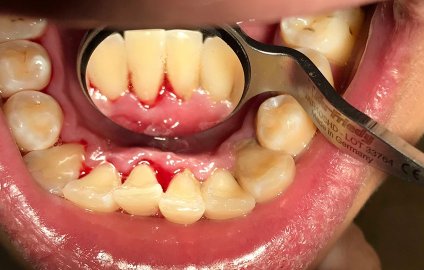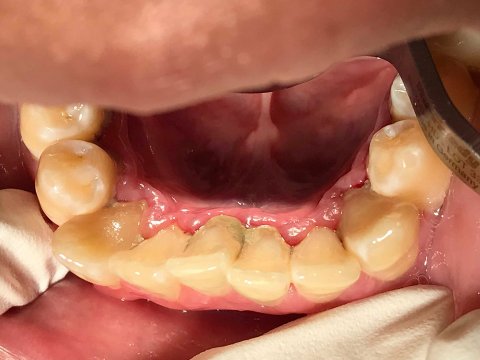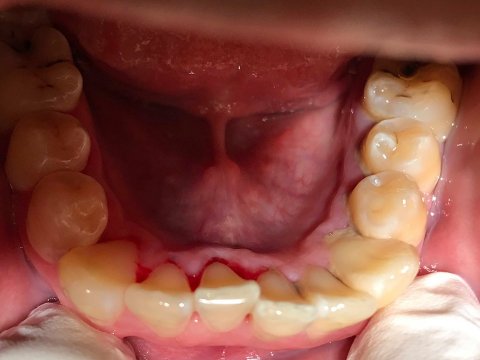25 year old Chinese male was present for an initial exam. His chief complaint was: “My gums bleed very often. I need a cleaning and thorough exam.” His last dental exam/cleaning/radiographic exposure was over 10 years ago.

right occlusion 
front view 
left occlusion
Medical History:
Blood pressure and pulse were taken two times at initial visit because patient presented with elevated readings. BP 135/90 P 80 at 2:20pm and BP 138/90 P 78 at 3:15pm (elevated blood pressure readings were noted and adult referral form was dispensed). Afterwards, vitals were taken at the beginning of every visit. Patient reported no known allergies and does not take any medications – ASA I.
Reported Self-Care:
Patient uses manual medium-bristled toothbrush with Sensodyne toothpaste twice a day using vertical strokes and Fones method. He rinses with Listerine antiseptic mouthwash every night before bed.
Extraoral/Intraoral/Dental Conditions:
Patient presented with generalized red pustules on cheeks and neck. There was a 3mm aphthous ulcer on the floor of the mouth (it was healed by V2). Patient had 20% overbite, 3mm overjet, and bilateral Class I occlusion. Multiple occlusal carious lesions were identified (adult referral was dispensed). Occlusal caries were most likely due to inadequate oral care (patient has not visited a dental office for over ten years) – which led to worn occlusal surfaces – and frequent consumption of fermentable carbohydrates.
Gingival Assessment/Deposit Statement:
Gingiva presented with erythematous margins and spongy interdental papilla. Tissue consistency was soft and there was severe bleeding upon probing. There were localized moderate supragingival calculus on the linguals of #18 – #31 and generalized moderate interproximal subgingival calculus in both arches.

Pre-Scaling: LRQ and LLQ with calculus 
Comparison of LRQ being scaled and LLQ not scaled yet
Post-Scaling of LRQ
Periodontal/Dental Charting:
Patient was classified as a heavy case value and perio type II. Patient presented with clinical 2-3mm gingival recession on the buccals of #3 – #6, #11 – #14, #20 – #21, and #28. Probing depths were generalized 3 – 4mm with localized 5mm readings on the surfaces of the molars. There was minimal (10%) generalized radiographic bone loss with no mobility and no furcations. Additionally, patient does not have any dental restorations.
Treatment Care Plan:
His care was divided into three visits.
—V1: BP 135/90 P 80 at 2:20pm; BP 138/90 P 78 at 3:15pm (elevated blood pressure readings were noted and adult referral form was dispensed). Completed assessments and exposed FMS. FMS was necessary as the patient had heavy deposits and had not visited the dentist in 10+ years. However, due to the x-ray room schedule, the FMS was exposed towards the end of clinic and there was not enough time to scale. Patient’s FMS displayed no interproximal caries, minimal bone loss, and all four molars are impacted.
—V2: BP 123/89 P 77. Tissue re-evaluation – tissue looked the same as it did at initial visit with moderate inflammation: generalized erythematous and spongy margins, severe BOP; patient education – reviewed the importance of oral hygiene to reverse gingivitis and prevent periodontitis, flossing with string floss and C-curve technique; debrided URQ and LRQ with ultrasonic and hand instruments.
—V3: BP 125/85 P 76. Tissue re-evaluation – no changes from V2; patient education – introduced electronic toothbrush, discussed the importance and urgency to see general dentist to evaluate carious lesions, and recommended to rinse with 0.05% NaF twice a day as patient is high risk for caries; scaled ULQ and LLQ with ultrasonic and hand instruments; engine polished with fine grit paste, applied 5% NaF varnish. Post-op instructions: Soft food diet with no alcohol, crunchy foods, hot drinks 4 – 6 hours post-treatment. Resume hygiene routine the following day. Rinse with warm salt water to relieve bleeding and soreness. Next recare visit is June 2019 (3 MRC).

Pre-Scaling: LRQ and LLQ with calculus
Comparison of LRQ being scaled and LLQ not scaled yet
Post-Scaling of LRQ
Oral Care Recommendations – Summary:
Since this patient presented with gingival recession and occlusal caries, an electronic toothbrush and fluoride mouth rinse were recommended. Additionally, since patient does not regularly floss, the string floss with C-curve technique was recommended. However, floss picks were also suggested to prompt the patient to incorporate flossing to his oral regimen.


